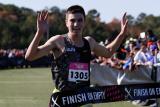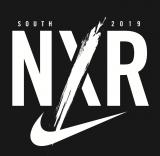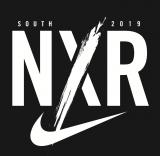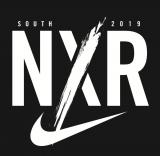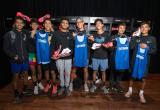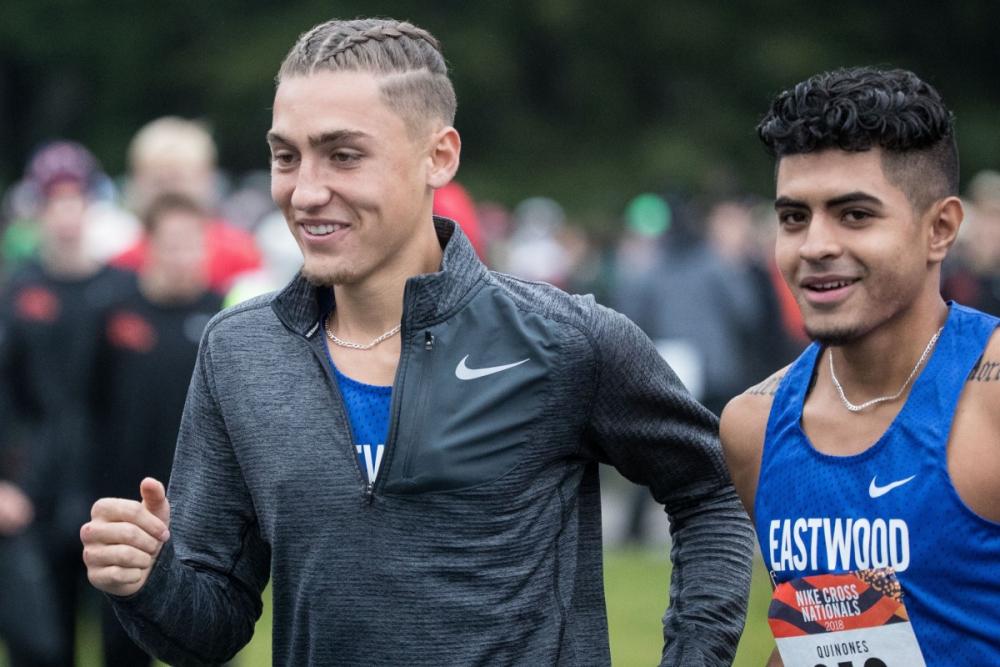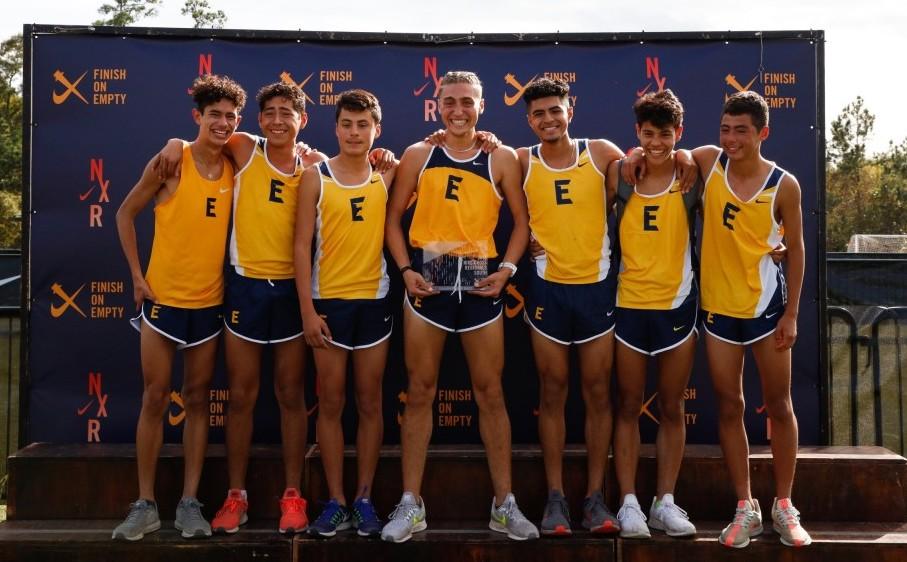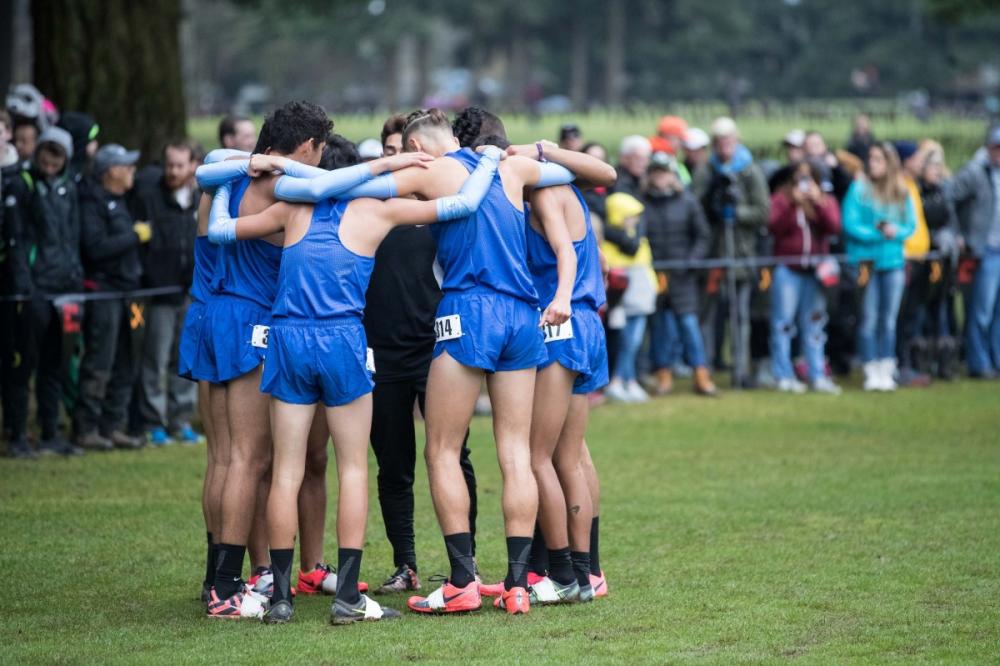Folders |
Remember the Names - El Paso Eastwood's Boys And The Quest For NXN RedemptionPublished by
Remember the Names Eastwood High and a Quest for NXN Redemption
A DyeStat story by Dave Devine ________
It was a small detail. The kind of thing you might take for granted. A simple, practical placard above a wooden locker. A necessary nametag, so the boys from Eastwood High in El Paso, Texas — just like every other team that qualified for the 2018 Nike Cross Nationals — could locate their gear in a staged locker room at Nike’s Tiger Woods Center. Rotate through, hear their squad announced by a booming, disembodied voice in an empty auditorium, and then visit a row of hastily customized lockers loaded with apparel and shoes. The type of thing you might glance at briefly, consult in the bouncy chaos of teammates and cellphone cameras capturing the moment — Hold up, which locker’s mine? — and then abandon in the exhilaration of Swooshed-out swag. Just a thin black strip with each runner’s name in bold white lettering at one end, the distinctive NXN logo in orange at the other. A name above a temporary locker. But it meant something, seeing those names in that room. CUARTAS…PEREZ…GALLEGOS…OLMOS… Not just because all the names were Latino, which they were, but because they were their names. A bunch of kids from El Paso. A city tucked in a corner of Texas that had never sent a team to NXN. The Troopers of Eastwood. Up there, all-caps: HERNANDEZ…PEREZ…QUINONES. Not one of the expected squads from the Dallas suburbs or the sprawling outskirts of Houston, but a different, unlikely team from the same state. A place an entire day’s drive from those larger cities. Of course, the Eastwood boys held up the unfamiliar blue singlets to size them against their thin chests. They laughed in disbelief at the fresh, futuristic spikes, imagining the mud they’d soon gather. They joked and took photos and blinked at the auditorium spotlights and ran stunned fingers along the seams of apparel they might otherwise never afford. Dude, I can’t believe this is all ours. But when Eastwood’s time in that room ended, when they were shuffled off so the lockers could be redone for the next team, they made sure to pry the name plates loose, too. Removed them and carefully tucked them away. Because the names were theirs, too. And two days later, after a disappointing race that saw them finish 22nd in a field of 22 teams, they carried those name plates home on the plane. Not as mementos, in case they never made it back to Portland again. This team was too young for that; only two seniors in the top seven. They took the names as a reminder of what it was like to see them hanging above those lockers in the middle of that gleaming campus. Of what it would take to get those names back there again.
There are so many borders to consider. A dizzying collection of dividing lines to assess and navigate, examine and bridge. This is high school athletics, after all, in one of the largest states in the country. There are lines between affluence and poverty. Access and isolation. Participation and apathy. Commitment and complacence. Between large schools and small; public and private. Race and class and tax bracket. Some of the divides are psychological, like the entrenched, pernicious feeling that a school way out in the margins has no business competing with the big city schools brimming with resources. No right to harbor dreams of national championships. Others are physical, like the numbing, inexorable ribbon of highway that connects El Paso to the metropolises in the east — over 600 miles to Fort Worth and Dallas, 750 to Houston. Or the border with a capital-B to the immediate south, the one carved by the winding Rio Grande that divides El Paso from Ciudad Juárez. The United States from Mexico. That’s the border that receives most of the attention outside this city, the border of headlines and heated political debates. Sound bites and sensationalism. Which makes it a facile frame for discussing an overachieving band of high school harriers: The Boys on the Border. But you’ll forgive longtime Eastwood coach Michael McLain if that’s not the border he chooses to reference when discussing his team or his hometown. There are so many other borders to consider. El Paso, he says, is a comparatively poor city. The high school where he’s taught and coached for 18 years falls somewhere in the middle in terms of resources and wealth. “We’re in the center of a city,” McLain says. “We’re definitely not a suburban school. We’re the old school, not the shiny new one where all the houses are being built and all the kids want to go. A lot of the young kids who are in running clubs, they don’t come to our school. It means we’re always the underdog.” McLain, a highly-regarded Anatomy and Physiology teacher at Eastwood, was an all-state runner at nearby J.M. Hanks High before competing collegiately at the University of Texas at El Paso. He began his prep coaching career back at Hanks, then spent time at three other area schools before finding a permanent home at Eastwood. “Early in my career,” he says, “moving around was great because I learned a lot from different coaches — and not just running coaches, coaches in other sports, too. But being able to stay at Eastwood for a long time is also the reason we’ve been able to build something.” And what he’s built — patiently, methodically, over the course of nearly two decades — is a successful program structured around a culture of hard work that has matured through regional-, state-, and now national-level success. The story of that team, he insists, is the story of all the guys, from the top seven studs to the last junior varsity finisher. It’s the story of kids like Jonah Camposano, a junior knocking on the varsity door who hasn’t quite kicked it open yet. Camposano was a freshman on marching band when he gave cross country a try, and was then convinced by McLain to go all-in after showing promise sophomore year. “One of the things about Coach McLain,” he says, “is that he really notices people if they work hard, even if they’re not right away on the varsity team. He sees that their hard work can get them somewhere.” Kayn Quinones, a senior leader on the 2018 NXN qualifying team, knows that all too well. He now competes collegiately for UTEP, McLain’s alma mater. “He’s a great coach,” Quinones says. “He definitely makes you want to work hard. It’s not difficult at all, trying to buy into his program.” Juan Olmos, a junior on that NXN squad now leading the 2019 Troopers, cracks up talking about McLain’s approach to coaching. “He’s a crazy guy,” he laughs, “he really is, but it works.” Mostly, Olmos appreciates that his coach refuses to allow the runners to get down on themselves, or be defined by how others might view them. “He’s been there for every single one of us,” Olmos says. “He puts in so much more than he needs to for us, so we have to do the same.”
Eight years ago, in the fall of 2011, McLain received an email from John Sullivan, a Nike regional ambassador, inviting him to bring his team to the NXN South Regional race. “The sad thing is,” McLain acknowledges, “I went, ‘What’s Nike South?’ I didn’t know what it was.” This, despite the fact that teams from Texas had been qualifying for NXN since the meet’s inception in 2004. That the Woodlands and Southlake Carroll were familiar contenders nearly every year. That the boys from Boerne Champion had won it all in 2009. And that the South regional race, drawing teams from five surrounding states, is actually held in Texas. And yet McLain, who had been coaching at Eastwood for a decade at that point (and four other El Paso schools prior), had never heard of the meet. He mostly attributes this lack familiarity to El Paso’s geographic isolation relative to the other major Texan cities. The 10-hour drive to Dallas. Nine hours to San Antonio. A dozen to Houston. Trips that involve crossing time zones. “When we go to Nike South,” he says, “we drive in a bus overnight because it’s about a 12-hour drive for us. Then we get off the bus, and we run.” Most teams, he notes, drive three hours or less. Or they fly into Houston, where the qualifying meet is held. “Because of our location, and the fact that we are not as affluent as a lot of the other schools that are successful in cross country, we drive everywhere we go.” Those long bus rides, McLain allows, come with positives and negatives. His runners are often tired when they arrive, and since trips to big meets are often overnight, sleep comes fitfully, at best. But the protracted drives also forge connection and identity, engendering a resilience that other squads might struggle to match. “We get used to traveling and competing in many different situations,” he says. “It forces us to deal with that.” From that initial emailed invitation eight years ago, and a resultant ninth-place finish in Eastwood’s first foray to a Nike regional meet, McLain set about solving two intractable challenges: how to raise enough money to travel to the meet each year, and how to elevate his team’s performance to match the Texas powers that tended to qualify every November. On the first concern, he quickly realized that he and his staff would have to get better at fundraising, and would need to figure out how to do that year-round. Noticing that none of the road race timing companies in El Paso offered chip-based timing, he started his own timing company, purchasing the components separately and assembling a system himself. “It’s a lot of work,” he acknowledges, “and we don’t charge a lot of money — nobody in El Paso has that kind of money.” But the timing company, and an annual summer road race the team stages, have nonetheless become a reliable income source. Beyond that, “we sell candles…we sell T-shirts… whatever we can do to make that money and travel, that’s how we do it.” A major reason McLain is so committed to traveling is that he’s seen how the promise of team trips provides a key solution to the second identified challenge: How to get better. On that front, he’d begun with something that comes naturally to an anatomy teacher. “I started researching,” he says. “Looking at these teams that make it to NXN every year, trying to find some commonality.” He attempted to identify shared philosophies or overlapping approaches to training — What’s the common workout all these teams are doing? — but soon found himself vexed by that line of inquiry. Some programs were high mileage, some low-mileage. Some high-intensity, others low impact. Year-round speedwork, never-touch-a-track-in-the-fall, singles and doubles and everything in between. “What I did find,” he notes, “is they were all coming from mostly affluent schools. And so, my question and my focus became, ‘Why are the affluent schools out-performing middle-class and poorer schools?’” He watched interviews with coaches from rival programs, noting an unmistakable ethic of hard work woven into the most successful team cultures. How, he wondered, do I get my kids to commit to working that hard? The promise of travel to big meets — in and out of state — has been one potent motivator. Another has been a coveted prize he’s embedded into team tradition: The Trooper 365 Award. Any Eastwood runner who commits to running every day, for 365 days straight, earns a Nike backpack embroidered with their name and a custom “Trooper 365” logo. Quinones, the recent alum now at UTEP, earned his backpack junior year. “It’s easy enough to say you ran every day of the year,” he acknowledges, “but to actually do it? And stay true to that? It was a great thing to be able to work toward that.” Camposano, the current JV runner, is working on his award as he tries to crack the varsity seven. “I’m hoping to get it in the summer of next year,” he says. “It really does help me. If you run every day, you actually do get better. You’ll get better work ethic and consistency.” Like nearly everything associated with coaching this team, the Trooper Award comes at a cost to McLain, but it’s an expense he’s willing to absorb. “Of course, that was money out of my own pocket,” he says, “but it started motivating these kids to work as hard as the kids who are making it to NXN every year.” And with each successive season, Eastwood’s performances at NXR South validated McLain’s belief. There was a sixth-place finish in 2015, followed by a fourth in 2016 and third in 2017. But the divide remained: Only the top two teams at the regional meet receive an automatic berth to the NXN championship. “We just kept getting closer and closer,” McLain says. In back-to-back years, Eastwood star Daniel Bernal qualified as an individual — the first runner from El Paso to ever make it to Portland — finishing as a 10th-place All-American at the 2017 NXN his senior year. It was a performance that not only inspired the younger runners on the team, but opened a door to what’s possible. “Instead of it being this pretty cool thing to go to,” Quinones says, “it became something we could actually see ourselves going to.” With Quinones and fellow senior Eddie Gallegos III assuming the leadership reigns in 2018, the Troopers set out to add to Eastwood’s legacy. They carved out an identity around tight, interchangeable packs and the narrowest possible compression between their first and fifth scorers. In early November, the team claimed the Texas 5A state title with a 30-second spread, and then arrived at Bear Branch Park north of Houston ready to validate months of work with a big performance at NXR South. Although their first scorer, Sergio Leon Cuartas, didn’t cross until 28th place, Eastwood stunned the field with a paper-thin 11-second compression from 1 to 5, receiving an automatic bid to Portland with a 121-point victory. When the title was announced, the team and their supporters reeled in disbelief, sobbing tears of joy. “Even speaking of it now,” Olmos says, a year later, “it gives me goosebumps. It was an amazing feeling, not only because we won, but because we did it for all the other teams that built the dreams we accomplished.” McLain, who had long imagined delivering a team to NXN, but had come to peace with the idea it might never happen, was similarly overcome. “It was just really cool last year when —” he says, pausing for the words to encompass that moment, “— when the dream happened. It was an eight-year journey.”
Daniel Bernal had tried to get them ready. The two-time NXN qualifier and now Furman University harrier had regaled his former Eastwood teammates with stories of the sights they might encounter in Portland. The rock star treatment and the ridiculous talent, the opportunities and the distractions. “He told us the stories of how crazy-elite all these high school runners are,” Quinones recalls, “and he also came with a lot of pictures to show us, so he got us pretty excited about all the things that were out there.” But even the photos and the vivid descriptions couldn’t do justice to what the Troopers encountered when they disembarked at the team hotel in Beaverton, Oregon. For the kids used to overnight bus trips and bargain hotels — if hotels were even in the budget — it was all a bit overwhelming. “We got there and saw the team banners,” Quinones says, “saw the hotel room — like we were at some 5-star resort, which it basically was — man, we were just all ecstatic, because we were never used to anything like that.” The sense of amazement only continued as the weekend progressed. “Every little thing was like something new,” Olmos recalls, “something unexpected.” The December weather; the rolling, verdant golf course layout; the meet atmosphere; even the composition of the teams from all over the country — all of it was novel and different. McLain remembers a rival coach and good friend from a team in New Mexico saying how inspired his runners had been, following the Eastwood squad during the NXN on-line coverage. “They were so excited,” McLain recalls his friend saying, “because they had never seen a team at NXN in which every kid on the team was Hispanic. And I didn’t even realize that. I went, ‘Is every kid on my team Hispanic? Really?’ and I went through the list and it was true. I didn’t even really notice it.” The Eastwood team was noticing, even if they didn’t give that distinction much weight. “I’d be lying,” Quinones says, “if I said we didn’t notice a difference between us and the other teams, but honestly, it wasn’t anything too crazy.” His junior teammate, Olmos, had a similar take. “We normally don’t look at our background or ethnicity against each and every team, we just run and represent our city. But every now and then (in Portland) we would acknowledge that fact, like, ‘Dang, maybe we are the first fully Hispanic team, and that was really incredible to be able to see that.” Back in El Paso, the rest of the Troopers were inspired, too, even if they had a difficult time picking out their friends in the custom blue uniforms on the streaming coverage. “We got so used to see them wearing the Eastwood uniforms,” Camposano says, “so it was kind of different to see them in the [Nike-issued] national uniforms. But we saw all the things they did in Portland, and it was like, Oh man, that’s cool.” The only part that wasn’t cool, it turned out, was the race itself. “Everything that could go wrong, did,” Quinones says, succinctly. He had been sick for several days before the team boarded the flight to Portland. Other guys suffered poorly-timed “off” races. Eastwood’s normal second man crossed as their sixth. The typical seventh guy rallied to score as their third. But the overall result was a disappointment. Twenty-second out of 22 teams. The trademark compression had ballooned from 11 seconds out to 36, allowing copious infiltration in the packed field. “We just weren’t used to running with such a great number of amazing runners,” Olmos says. “To be surrounded by nothing but the nation’s best, it was a really different experience.” For Quinones, the humbling finish came down to a struggle to identify a new objective after the years-long dream of securing a bid to the NXN final was achieved. “The goal for all of us was to qualify, but after we qualified it was like, ‘We made it. We’re good.’ We thought we might get that far, but we never really thought about what we’d do once we got there. We enjoyed the experience, but I guess we weren’t in the racing mindset.” His coach agrees. “When for eight years,” McLain reflects, “your goal was to make it to Nike, well, you haven’t really addressed what happens after you make it Nike. We need to make sure we make it back here, and make sure that next time, people see Eastwood.”
Juan Olmos is thinking about next time. He’s lying in his bed at home in El Paso, as he does some evenings, just before turning out the lights, contemplating a narrow black strip on his wall. It’s a simple placard with a name at one end — his name, all caps — and at the other end, the logo of a national championship cross country meet. A familiar Swoosh bisected by a racing spike. A reminder of where he’s been, where he’s hoping to go. He knows that in other teenage bedrooms in other El Paso houses, there are similar nametags hanging on the walls. All the guys that qualified for NXN last year, the ones who tucked those placards in their bags, carried them back to their city. “We keep them in our homes,” Olmos says. “Above our beds. When we’re hanging out, meeting up for runs, we all noticed that we’ve kept them.” Not as memento. As motivation. “We see it,” Olmos says, “and we’re reminded at the end of the day that we have something we’re working towards.” There’s no escaping the fact that this is a different team than last year. They’ve lost Kayn and Eddie, the two senior leaders, and the compression isn’t as tight as it was a year ago, but they have a more potent top three now — what McLain calls “my low-stick guys” — and a 4-5-6 that are working to close the gap. They began the season slotted 19th nationally on the DyeStat pre-season rankings, but after big meet clashes against national powers at Woodbridge in California and Desert Twilight in Arizona, the team has tumbled from the top 30. They’ve also slid from the top five in the most recent South Regional ranking. But this is nothing new for the Troopers of Eastwood. “We tend to get overlooked and under-ranked every single year,” McLain says. “Every year it’s, The end of Eastwood. They won’t be back. That, to us, is motivation.” If there was a bigger lesson to be drawn from last year’s NXN incursion, it’s that this is a team that hates to lose, but isn’t afraid to lose. Their coach has made sure of that. “I try to hammer it into my kids,” he says. “The best thing that can ever happen to you is failure. I don’t think we’re afraid to fail. We understand it’s a mechanism that can only push us more and push us harder.” It pushed them all summer, through the daunting workouts, the doubles, the long runs, the commitment to earning the backpacks — 365 days of showing up. Being out there for each other. And if all that work ends up being enough for another berth to the NXN final, McLain expects the outcome at Glendoveer Golf Course will be different this time. “If we do make it again, I know that our attitude will have shifted, and we’ll be focused on an opportunity that’s available to us there.” In the meantime, there are those nametags on the bedroom walls. Small details, easily overlooked. The kind of thing that runners from the other schools might have considered expendable, lost in the avalanche of shoes and singlets and jackets. Juan Olmos knows this, too. “It’s something so little,” he says, “that some people may take for granted, but we’re going to realize that, and we’re going to use that, like, ‘Hey, we’re working for the little things, and it’s going to accumulate so we can do the big things.’ It reminds us that all the little things build up.” It’s evening in El Paso. He’s not asleep yet, but he will be soon. The lights are about to go out on another day of hard work. A morning run awaits. This is what dreaming looks like. |

